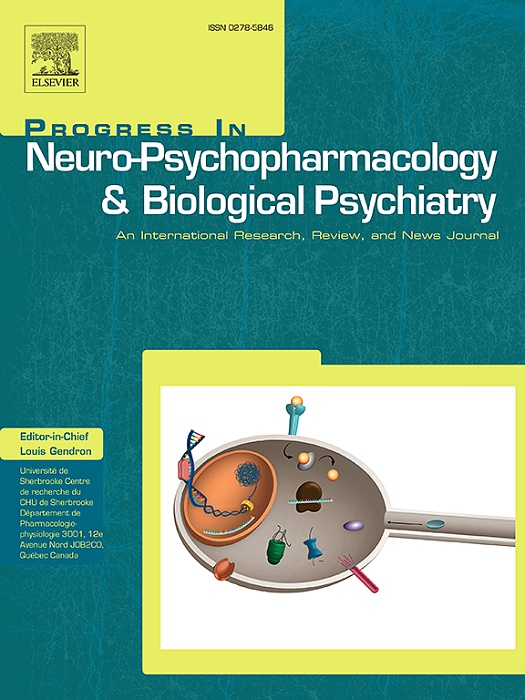Plasma neurofilament light chain levels are associated with delirium tremens in patients with alcohol use disorder
IF 5.3
2区 医学
Q1 CLINICAL NEUROLOGY
Progress in Neuro-Psychopharmacology & Biological Psychiatry
Pub Date : 2024-11-05
DOI:10.1016/j.pnpbp.2024.111189
引用次数: 0
Abstract
Delirium tremens (DT) is the most severe and life-threatening manifestation of alcohol withdrawal. Prompt identification and treatment are crucial in the clinical management of DT, but laboratory markers in this context are still lacking. Neurofilament light chain (NfL) has been proposed as a novel blood marker of neuroaxonal pathology. Therefore, we investigated the association between plasma NfL levels on admission and the occurrence of DT in patients with alcohol use disorder (AUD). NfL levels were measured on admission in 224 patients with AUD undergoing alcohol withdrawal treatment and in 116 healthy individuals. We monitored patients with AUD during the following 2 weeks of hospitalization and categorized them according to the prospective occurrence of DT (n = 25) or not (n = 199). Plasma NfL levels at admission were highest in patients who later developed DT, compared to AUD patients without DT, and healthy individuals (63.1 ± 47.2, 24.0 ± 22.4, 11.8 ± 6.1 pg/mL, respectively, p < 0.001). Receiver operating characteristic analysis revealed that a cut-off NfL level of 27.2 pg/mL could discriminate AUD patients who later developed DT (sensitivity: 80.0 %; specificity: 72.4 %; area under the curve: 0.84, p < 0.001), with an odds ratio of 9.43 (95 % CI 3.26–27.32; p < 0.001) for the risk of developing DT. Our findings suggest that NfL levels at admission may predict DT occurrence in patients with AUD and implicate neuroaxonal pathology in the pathophysiology of DT. Further research is needed to validate these findings and to explore the underlying neurobiological mechanisms.
血浆神经丝蛋白轻链水平与酒精使用障碍患者的震颤性谵妄有关。
震颤性谵妄(DT)是戒酒后最严重、最危及生命的表现。及时发现和治疗是临床治疗震颤性谵妄的关键,但目前仍缺乏这方面的实验室标志物。神经丝蛋白轻链(NfL)被认为是神经轴病理学的新型血液标记物。因此,我们研究了酒精使用障碍(AUD)患者入院时血浆 NfL 水平与 DT 发生率之间的关系。我们对 224 名接受戒酒治疗的 AUD 患者和 116 名健康人入院时的 NfL 水平进行了测量。我们在随后的两周住院期间对 AUD 患者进行了监测,并根据 DT 的预期发生率(25 人)或未发生率(199 人)对他们进行了分类。与未发生 DT 的 AUD 患者和健康人相比,入院时发生 DT 的患者血浆 NfL 水平最高(分别为 63.1 ± 47.2、24.0 ± 22.4、11.8 ± 6.1 pg/mL,P
本文章由计算机程序翻译,如有差异,请以英文原文为准。
求助全文
约1分钟内获得全文
求助全文
来源期刊
CiteScore
12.00
自引率
1.80%
发文量
153
审稿时长
56 days
期刊介绍:
Progress in Neuro-Psychopharmacology & Biological Psychiatry is an international and multidisciplinary journal which aims to ensure the rapid publication of authoritative reviews and research papers dealing with experimental and clinical aspects of neuro-psychopharmacology and biological psychiatry. Issues of the journal are regularly devoted wholly in or in part to a topical subject.
Progress in Neuro-Psychopharmacology & Biological Psychiatry does not publish work on the actions of biological extracts unless the pharmacological active molecular substrate and/or specific receptor binding properties of the extract compounds are elucidated.

 求助内容:
求助内容: 应助结果提醒方式:
应助结果提醒方式:


